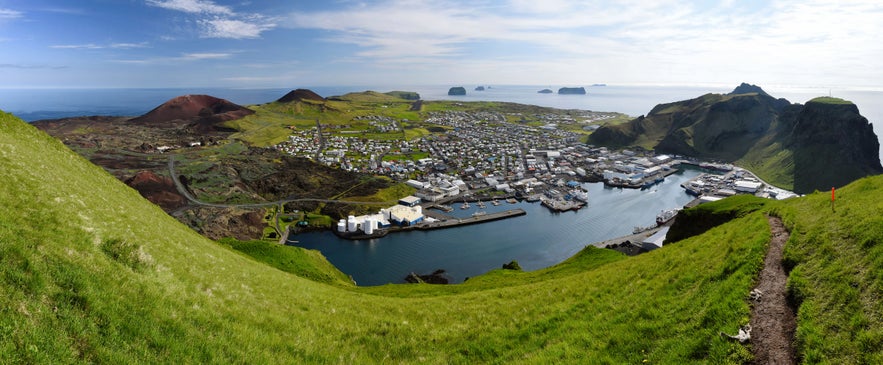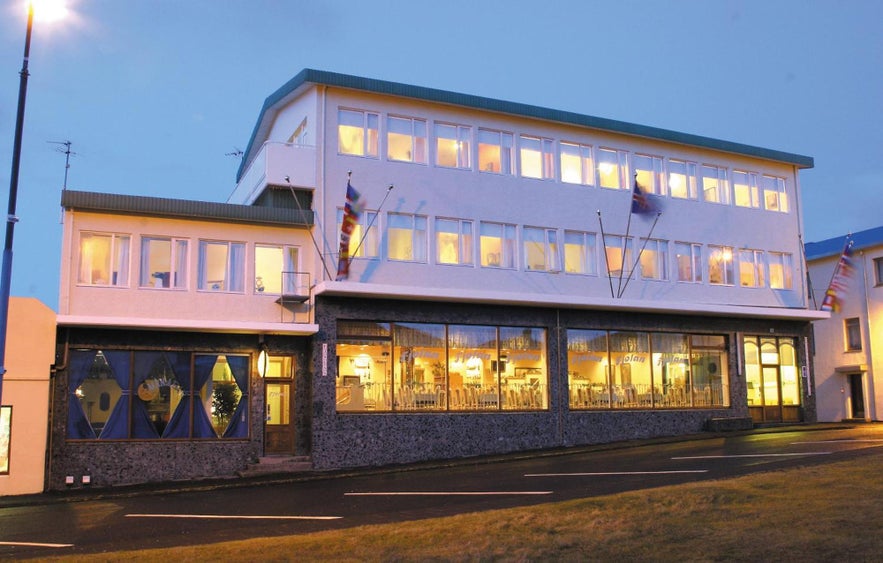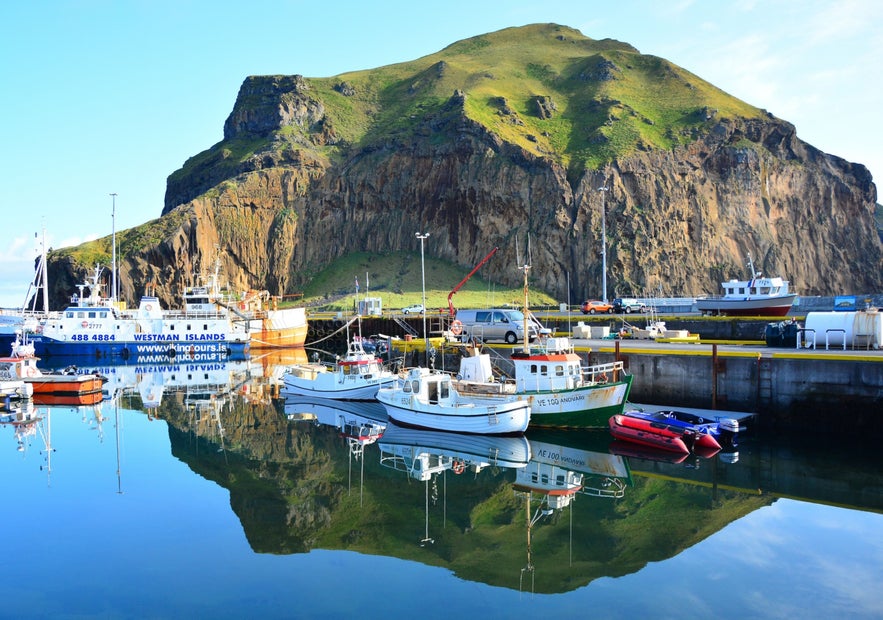
Heimaey is the only inhabited island in Iceland’s Westman Islands, known for its sea cliffs, puffins, and volcanic history. In 1973, a sudden eruption reshaped the island and forced a full evacuation. Today, you can hike the Eldfell Crater, walk cooled lava fields, and visit the Eldheimar Museum to see homes buried in ash.
Though just over 5 square miles (13 square kilometers), Heimaey packs in a wide range of experiences. Many of these are explored through guided Westman Islands tours, Heimaey shore excursions, and South Coast tours designed for short, efficient visits.
In summer, Heimaey’s cliffs become nesting grounds for millions of seabirds. Birdwatching tours bring you close to puffins, fulmars, and guillemots, either from viewing platforms or the sea.
To explore the coastline, travelers can join guided boat trips. A popular choice is a boat tour in Vestmannaeyjar from Heimaey Harbor, where local guides navigate sea caves and share stories of the island’s volcanic and marine environment.
This guide will walk you through everything you need to know for a successful visit to Heimaey, including its history, key attractions, and useful tips for planning your trip.
Why You Can Trust Our Content
Guide to Iceland is the most trusted travel platform in Iceland, helping millions of visitors each year. All our content is written and reviewed by local experts who are deeply familiar with Iceland. You can count on us for accurate, up-to-date, and trustworthy travel advice.
Key Takeaways
-
Puffin Paradise – Heimaey is home to the largest Atlantic puffin colony in the world, making it a must-visit for bird lovers.
-
A Town Built on Fire – The island’s dramatic volcanic history, including the 1973 Eldfell eruption, has shaped its landscape and resilient community.
-
Pirates & Vikings – From Viking settlers to the shocking 1627 pirate raid, Heimaey’s past is rich with captivating stories.
-
Epic Coastal Scenery – Towering sea cliffs, dramatic rock formations like Elephant Rock, and panoramic ocean views make Heimaey a dream for nature lovers.
-
Adventure Awaits – Whether you want to hike a volcano, swing along cliffs in the local sport of spranga, or take a thrilling RIB boat tour, Heimaey offers something for every traveler.
An Epic History — Pirates, Volcanoes, and the Resilience of Heimaey
Heimaey, Iceland, has a history of survival and unexpected twists. The first known people to inhabit the island were two escaped slaves from Ireland. Captured by the blood brother of Ingólfur Arnarson, Reykjavik’s founder, the two men killed their captor and fled to Heimaey, hoping to escape retribution.
Despite their efforts of evasion, Ingólfur tracked the men down, killing one before forcing the other to throw himself off a cliff to his death.
The island became known as the “Westman Islands” after the Irish slaves. The hill where the second man met his end was later named Duffy’s Hill (Dufthekja in Icelandic) in his memory.
Archaeological findings suggest there may have been earlier settlers on Heimaey, with evidence of homes dating back to around 800 A.D. However, according to the Book of Settlements, the first permanent settler arrived in 900 A.D.
Over time, the population of Heimaey grew, and the island’s rich fishing grounds attracted more settlers. The Danes established buildings on the island after taking control of Iceland, establishing Heimaey as a strategic port.
In 1627, tragedy struck Heimaey Island. Pirates from the Barbary fleet — part of the Ottoman Empire’s seafaring forces — raided the coasts of Iceland. Heimaey had no escape routes, and 237 residents were taken captive. Of those captured, fewer than 100 returned to Iceland after spending over a decade in slavery.
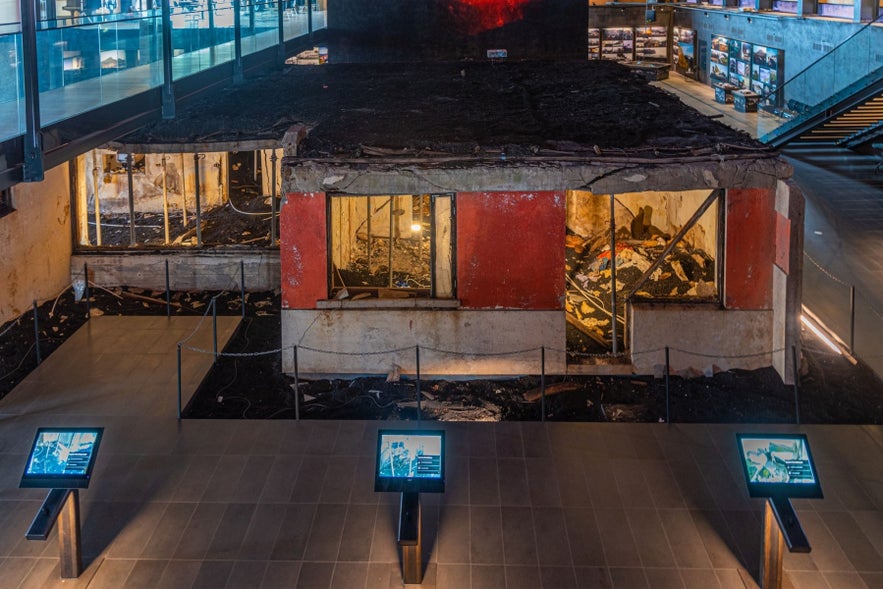 The island’s struggles were not over, though the following centuries were marked by relative peace. That peace lasted until 1973, when the eruption of Eldfell ripped through the middle of the town. Fissures stretched over half a mile (0.8 kilometers), and lava and ash destroyed more than 400 homes. Miraculously, all 5,300 residents were safely evacuated, with only one recorded death.
The island’s struggles were not over, though the following centuries were marked by relative peace. That peace lasted until 1973, when the eruption of Eldfell ripped through the middle of the town. Fissures stretched over half a mile (0.8 kilometers), and lava and ash destroyed more than 400 homes. Miraculously, all 5,300 residents were safely evacuated, with only one recorded death.
The 1973 eruption was a turning point for Heimaey. Though it destroyed much of the town, residents acted swiftly, with local and international teams pumping seawater onto the lava to save the harbor. This effort not only preserved the port but also improved it, enabling Heimaey’s thriving modern economy.
Today, Heimaey’s economy revolves around fishing and tourism. Fishing remains vital, with the surrounding waters rich in cod and herring, while the port supports local fish processing plants. Tourism has grown significantly, with visitors attracted by the island’s history, volcanic landscapes, and the world’s largest puffin colony.
Heimaey — A Seabird Sanctuary on Volcanic Shores
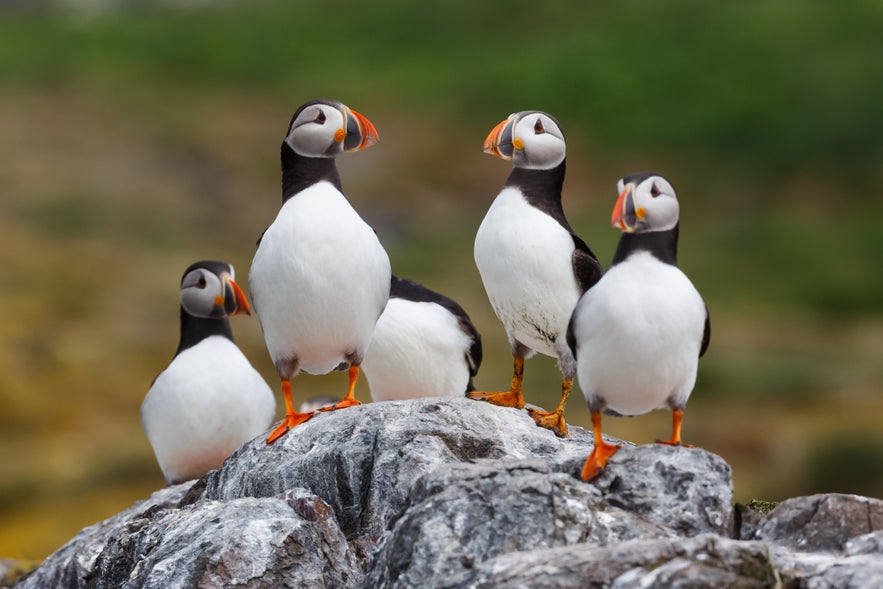
Each summer, thousands of young puffins, known as pufflings, take their first flight from Heimaey’s cliffs. Drawn by the town’s lights, many become disoriented and land on the streets instead of the open sea.
This is where the Puffling Patrol steps in — a beloved tradition where local children and volunteers collect lost pufflings, keep them safe overnight, and release them into the ocean to join their fellow puffins the next day. Visitors can participate in this effort, making a truly memorable experience while helping Heimaey’s most famous residents find their way home.
Heimaey’s natural beauty is striking, with its volcanic terrain and lush green hills. The island’s cliffs and volcanic history offer scenic contrasts, and Eldfell Volcano stands as a reminder of its fiery past. Wildlife enthusiasts can also spot seals and seabirds, making the island a nature lover’s paradise.
Top Things To Do on Heimaey Island
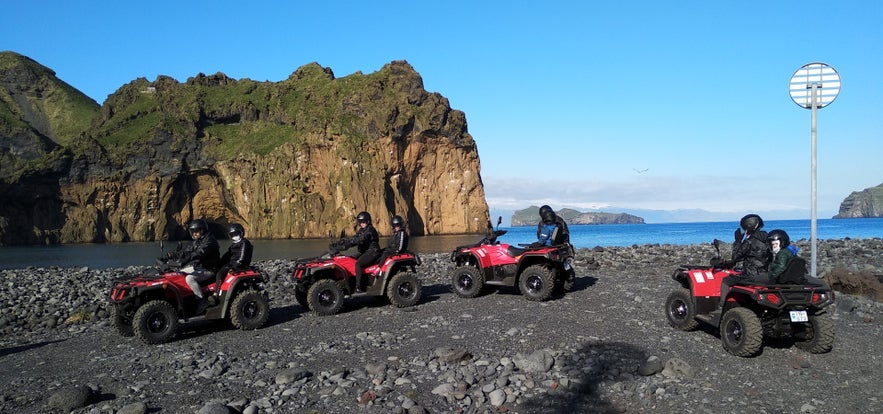 Enjoy the following land adventures in Heimaey Island.
Enjoy the following land adventures in Heimaey Island.
Whether you’re drawn to Heimaey for its rich history, stunning natural wonders, or vibrant wildlife, the island offers a range of activities for every traveler. From hiking volcanic craters and spotting puffins to uncovering tales of pirates and volcanic eruptions, Heimaey is an adventure awaiting your exploration.
If you're curious about the surrounding archipelago, this guide to the Westman Islands offers even more ideas for what to see and do nearby.
Explore the Island’s Fiery Past
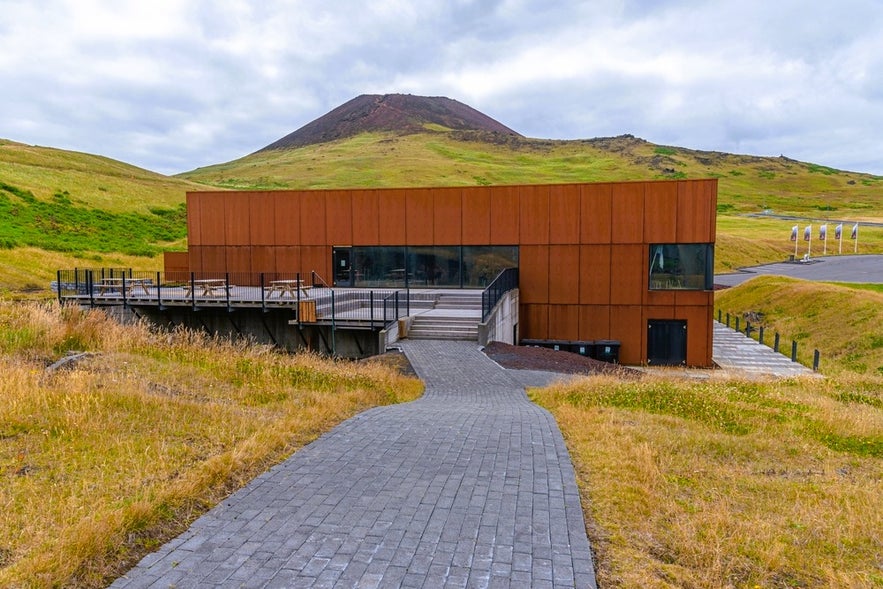 The eruption of Eldfell in 1973 forever changed the face of Heimaey, reshaping its landscape and testing the resilience of the people. Today, you can explore sites that bring this powerful moment in history to life.
The eruption of Eldfell in 1973 forever changed the face of Heimaey, reshaping its landscape and testing the resilience of the people. Today, you can explore sites that bring this powerful moment in history to life.
-
Eldheimar Museum – Walk through a preserved home buried in ash from the 1973 eruption and learn how the islanders fought to save their town.
-
Eldfell Volcano – Hike up the volcano responsible for the disaster and feel the lingering warmth beneath your feet.
Take in the Stunning Coastline and Wildlife
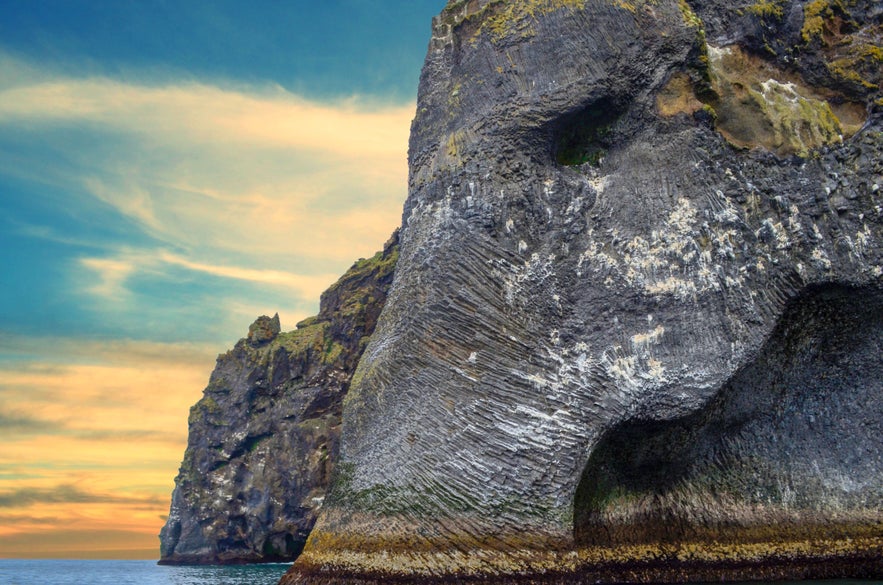 Heimaey’s impressive coastline, soaring bird cliffs, and rich marine life offer some of the best wildlife viewing in Iceland. Whether you’re cruising past sea caves, scanning the waves for whales, or standing at the edge of a cliff as puffins soar overhead, the island’s natural wonders are never far away.
Heimaey’s impressive coastline, soaring bird cliffs, and rich marine life offer some of the best wildlife viewing in Iceland. Whether you’re cruising past sea caves, scanning the waves for whales, or standing at the edge of a cliff as puffins soar overhead, the island’s natural wonders are never far away.
Westman Islands Boat Tours
Choose between a high-speed RIB boat adventure for an adrenaline rush or a scenic boat tour to enjoy breathtaking views at a slower pace. These tours offer a unique perspective of Heimaey’s coastline from the water, passing sea caves and remote inlets.
Most routes also take you past Elephant Rock, a natural basalt formation that resembles an elephant dipping its trunk into the sea — one of the archipelago’s most iconic sights.
Whale and Puffin Watching in the Westman Islands
Heimaey is the best place to see Atlantic puffins, with more nesting here than anywhere else in the world. Visitors can also spot orcas, minke, and fin whales on boat tours.
On land, stop by the SEA LIFE Trust Beluga Whale Sanctuary — the world’s first open-water refuge for rescued belugas and home to a dedicated puffin rescue center.
Explore Storhofdi Peninsula — Where the Wind Roars
Visit the southernmost point of Heimaey and one of the windiest places in Europe, where you can watch thousands of puffins nest in the cliffs each summer.
On clear days, you can spot Surtsey Island in the distance. Featured on the UNESCO World Heritage list, it was formed by a volcanic eruption in the 1960s and left untouched by humans to serve as a living scientific laboratory.
Dive Into Heimaey’s Viking and Pirate History
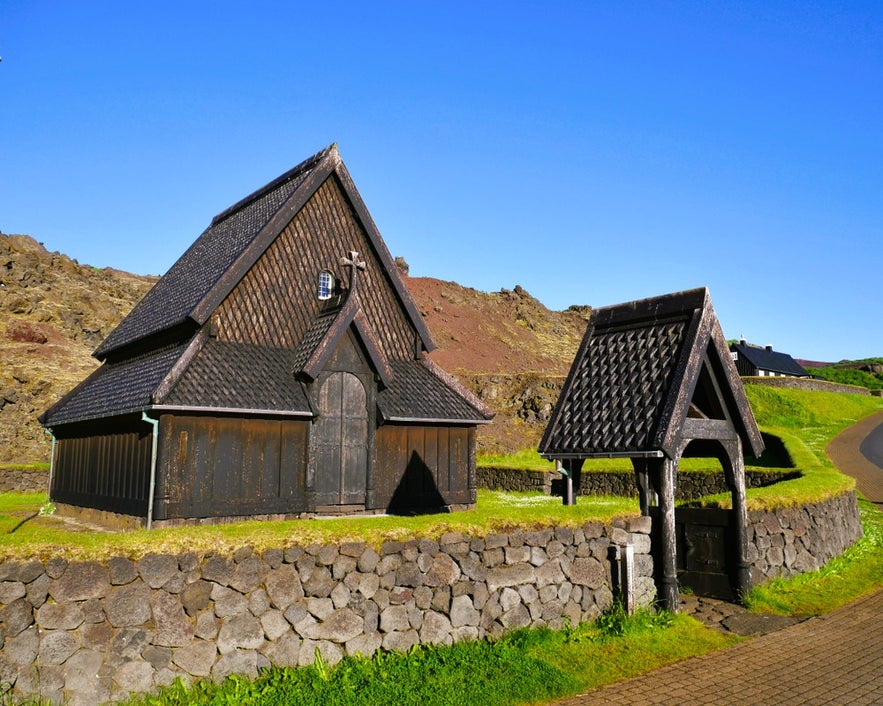 Heimaey’s past is filled with legendary stories — from Norse settlers to seafaring invaders. These historical sites offer a glimpse into the island’s deep roots and the dramatic events that helped shape its identity.
Heimaey’s past is filled with legendary stories — from Norse settlers to seafaring invaders. These historical sites offer a glimpse into the island’s deep roots and the dramatic events that helped shape its identity.
Heimaey Stave Church
Also known as the Stafkirkjan Church, the Heimaey Stave Church is a stunning replica of Norway’s Haltdalen Church, which was gifted to Iceland to honor their shared Viking heritage.
Raeningjatangi — “Pirate Cove”
Visit Pirate Cove, learn about the 1627 pirate attack that led to the capture and enslavement of 240 islanders, and see the Turkish Raid Memorial.
Adventure on Land
Spranga
Watch locals participate in the thrilling local sport “spranga,” which involves swinging from ropes along the cliffs — a skill traditionally used to collect seabird eggs.
ATV Tours
Race across lava fields and rugged coastal cliffs for an unforgettable off-road experience in an exhilarating 1-hour ATV volcano tour in Vestmannaeyjar.
Climb Heimaklettur Cliff
The highest peak on Heimaey offers a rewarding hike with breathtaking views of the island and surrounding ocean. The climb has steep sections with rope-assisted ascents to make it to the summit.
Tours That Include Heimaey Island
-
Small-Group 3-Day Sightseeing Tour – This small-group tour explores the Westman Islands, South Coast, and Highlands, combining Heimaey’s volcanic history and wildlife with Iceland’s stunning waterfalls, glaciers, and rugged interior.
-
11-Day Adventure Road Trip Along The Ring Road of Iceland – This 11-day, self-drive tour takes you through Iceland’s most breathtaking regions, including a visit to Heimaey, where you can explore its volcanic landscapes, rich history, and diverse wildlife.
-
Small-Group 12-Hour Day Tour from Reykjavik – This Vestmannaeyjar day tour offers a guided exploration of Heimaey, where you can discover the island’s volcanic history, wildlife, and stunning coastal views.
How To Get To Heimaey
Reaching Heimaey is easy, with both ferry and flight options available for visitors.
The Herjolfur Ferry connects Landeyjahofn on the South Coast to Heimaey, offering a scenic 35-minute crossing. Ferries run regularly throughout the day. Reservations are recommended, especially during the high summer season.
The ferry can carry both passengers and vehicles, making it a convenient choice for those traveling with a rental car or exploring the island at their own pace.
Alternatively, you can take a 30-minute flight from Reykjavik Domestic Airport to Heimaey Airport.
Where To Eat and Stay in Heimaey
Heimaey offers a range of dining options and cozy accommodations to make your visit even more memorable.
Where To Eat
-
Slippurinn – Known for its modern take on traditional Icelandic dishes, this harborside restaurant offers locally sourced seafood and an unforgettable atmosphere.
-
GOTT – This scratch kitchen offers healthy, creative meals made from scratch using fresh, local ingredients, with dishes crafted by chef Sigurður Gíslason, a former member of Iceland’s national culinary team, and his wife Berglind Sigmarsdóttir.
-
Einsi Kaldi – A fine-dining restaurant in Heimaey, known for its exquisite Icelandic cuisine, using fresh, locally sourced ingredients in a sophisticated, intimate setting.
Where To Stay
-
Hotel Vestmannaeyjar – A comfortable, modern hotel offering great views of the harbor and convenient amenities such as a spa and restaurant.
-
Guesthouse Hamar – A charming guesthouse near the town center, offering a relaxed and affordable stay with easy access to attractions.
-
Vestmannaeyjar Hi Hostel – This hostel provides affordable and comfortable accommodations in Heimaey, featuring cozy rooms, a communal kitchen, and easy access to the island's top attractions.
When Is the Best Time To Visit Heimaey, Iceland?
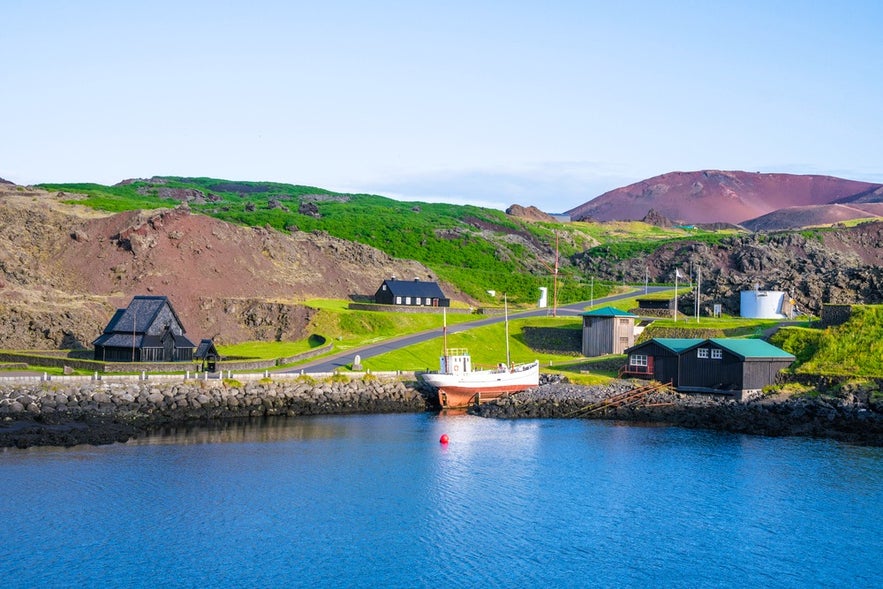 The best time to visit Heimaey depends on what you want to experience, with each season offering something unique.
The best time to visit Heimaey depends on what you want to experience, with each season offering something unique.
Summer (June to August)
This peak season is perfect for those wanting to see the island’s puffin colonies in full swing and enjoy warmer weather. You can also take advantage of long daylight hours for hiking, sightseeing, and boat tours.
Spring (April to May) and Fall (September to October)
These shoulder seasons offer fewer crowds while still providing excellent opportunities for whale watching and scenic hikes. The weather can be unpredictable, so be prepared for cooler temperatures and occasional rain.
Winter (November to March)
If you prefer a quieter, more serene experience, winter offers fewer tourists and the chance to see the northern lights over the island’s volcanic landscape. However, ferry schedules may be more limited, and weather conditions could affect travel.
Travel Tips
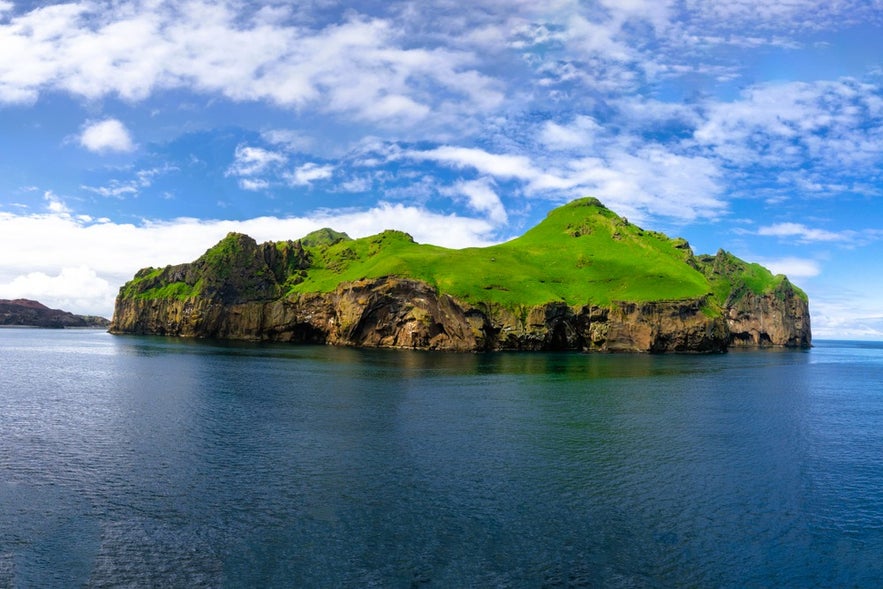
-
Book in Advance: Especially during summer, book ferry tickets and accommodation early, as the island can get busy.
-
Weather Preparedness: The weather in Heimaey can change quickly. Always pack layers and waterproof gear to stay comfortable while exploring.
-
Transportation: If you’re traveling by ferry, check the schedule for Herjdlfur Ferry in advance. Flights from Reykjavik to Heimaey are quick and convenient but may be weather-dependent.
-
Cash & Card: While many places accept credit cards, it's handy to have some Icelandic krona for small purchases, especially if you plan on visiting local markets.
FAQs About Heimaey
Here are some of the most commonly asked questions about traveling to Heimaey.
How do I get to Heimaey?
You can reach Heimaey by ferry from Landeyjahofn or by flight from Reykjavik Domestic Airport. Ferries are more frequent in summer, while flights are quick and convenient year-round.
Is it safe to visit Heimaey in winter?
Yes, though winter weather can be unpredictable, it’s generally safe to visit. Be prepared for changing conditions and check the ferry schedules or flight availability in advance.
Are there ATMs on Heimaey?
Yes, there are a few ATMs on the island, but carrying cash is a good idea, especially if you plan to visit more remote locations.
Can I hike on Heimaey?
Yes! Heimaey is perfect for hiking, with trails offering stunning views of the island’s volcanic landscapes and wildlife. Popular hikes include the route to Heimaklettur, the island’s highest point.
How do I say Heimaey?
Heimaey is pronounced as “Hay-my” (with a soft “H” and the emphasis on the first syllable). It’s a straightforward name once you get the hang of it. Common misspellings of Heimaey include:
-
Heimay Island
-
Hiemay
-
Hiemaey
Heimaey — An Island That Leaves a Lasting Impression
 Heimaey, with its rich history, breathtaking landscapes, and vibrant wildlife, is a must-see destination for anyone visiting Iceland. Whether hiking volcanic cliffs, watching puffins, or uncovering the island’s fascinating past, Heimaey offers something for everyone.
Heimaey, with its rich history, breathtaking landscapes, and vibrant wildlife, is a must-see destination for anyone visiting Iceland. Whether hiking volcanic cliffs, watching puffins, or uncovering the island’s fascinating past, Heimaey offers something for everyone.
Easily accessible by ferry or flight, it’s the perfect addition to your Iceland adventure. Visit in summer for a lively atmosphere, or explore its serene beauty during the shoulder seasons.
No matter when you go, Heimaey promises unforgettable experiences. Book your journey now and experience the magic of Heimaey for yourself!

